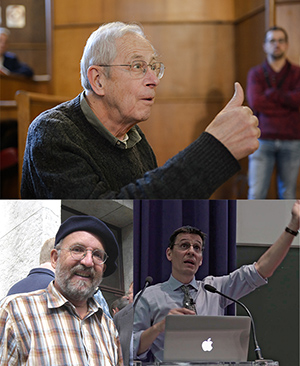NOBEL PRIZE IN PHYSICS 2019: JAMES PEEBLES, MICHEL MAYOR AND DIDIER QUELOZ
 James Peebles (2017)
James Peebles (2017)
Michel Mayor (2003) & Didier Queloz (2015)
Credit: Jean Mouette /IAP-CNRS-SU
The Institut d'astrophysique de Paris congratulates James Peebles, Michel Mayor and Didier Queloz for their Nobel Prize in Physics 2019 for “their contributions to our understanding of the evolution of our universe and Earth’s place in the cosmos”.
Half of the award goes to James Peebles, professor emeritus in the Physics Department at Princeton University (United States of America). He helped set up the foundations of physical cosmology as we know it today, through his innovative work on dark matter, dark energy, cosmic background radiation or the formation of large structures. At the Institut d’astrophysique de Paris (IAP), as in many cosmology laboratories around the world, the results of James Peebles have had a major and lasting influence on a some research topics. At the IAP, activities related to the Planck space observatory, the future Euclid space mission, as well as the works of the "Large structures and deep Universe" research group and the "Numerical simulations" group, all find their filiation in the legacy of James Peebles' works.
The other half of the prize goes to Michel Mayor, Honorary Professor at the University of Geneva, and Didier Queloz, Professor at the Geneva Observatory and the University of Cambridge (United Kingdom), for their discovery in 1995 of 51 Peg b, the first planet detected around a star similar to the Sun. Carried out at the Haute-Provence Observatory using the ELODIE spectrograph developed with the CNRS, this discovery was a real revolution. More than 4000 other exoplanets were subsequently detected; they allow the researchers to explore the diversity of planetary systems and to better understand their modes of formation and evolution (“exoplanetology”). These results also open the prospect of detection and study of other habitable planets, even inhabited. Exoplanetology is today a major subject of modern astrophysics. IAP teams have been involved in this theme for many years through various research programs, some in collaboration with the two new Nobel Prize winners.
The IAP has had long-standing relationship with James Peebles, Michel Mayor et Didier Queloz, as evidenced by videos of the various oral presentation they made in the amphitheater:
Writing: Karim Benabed, Guillaume Hébrard, Valérie de Lapparent
Layout, photographs and videos: Jean Mouette
October 2019
